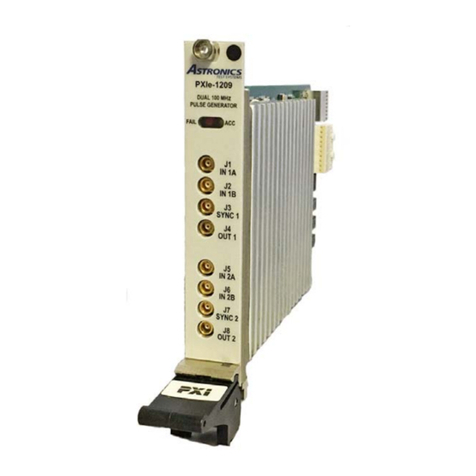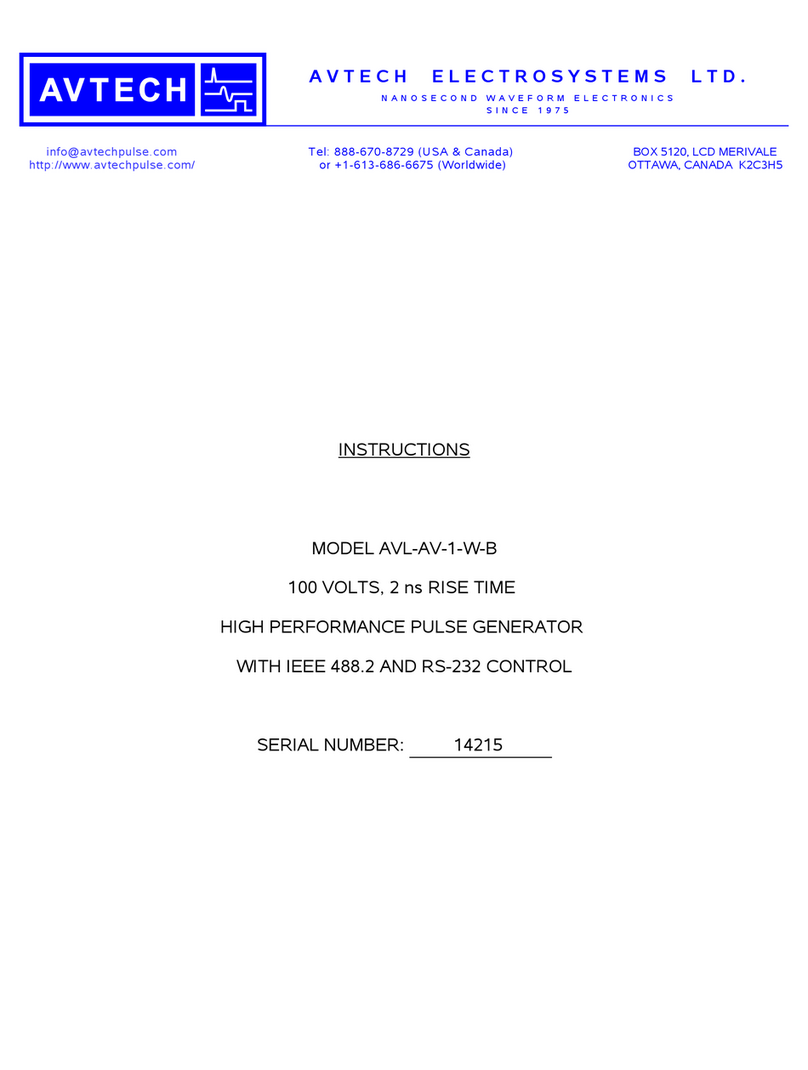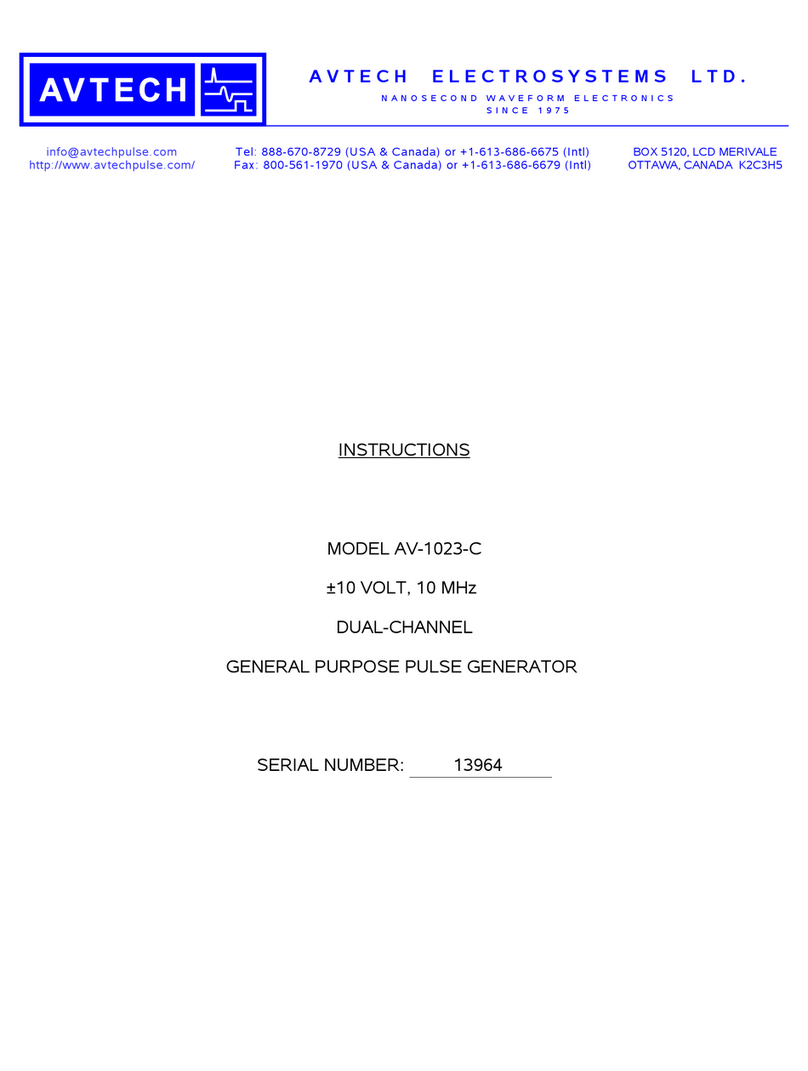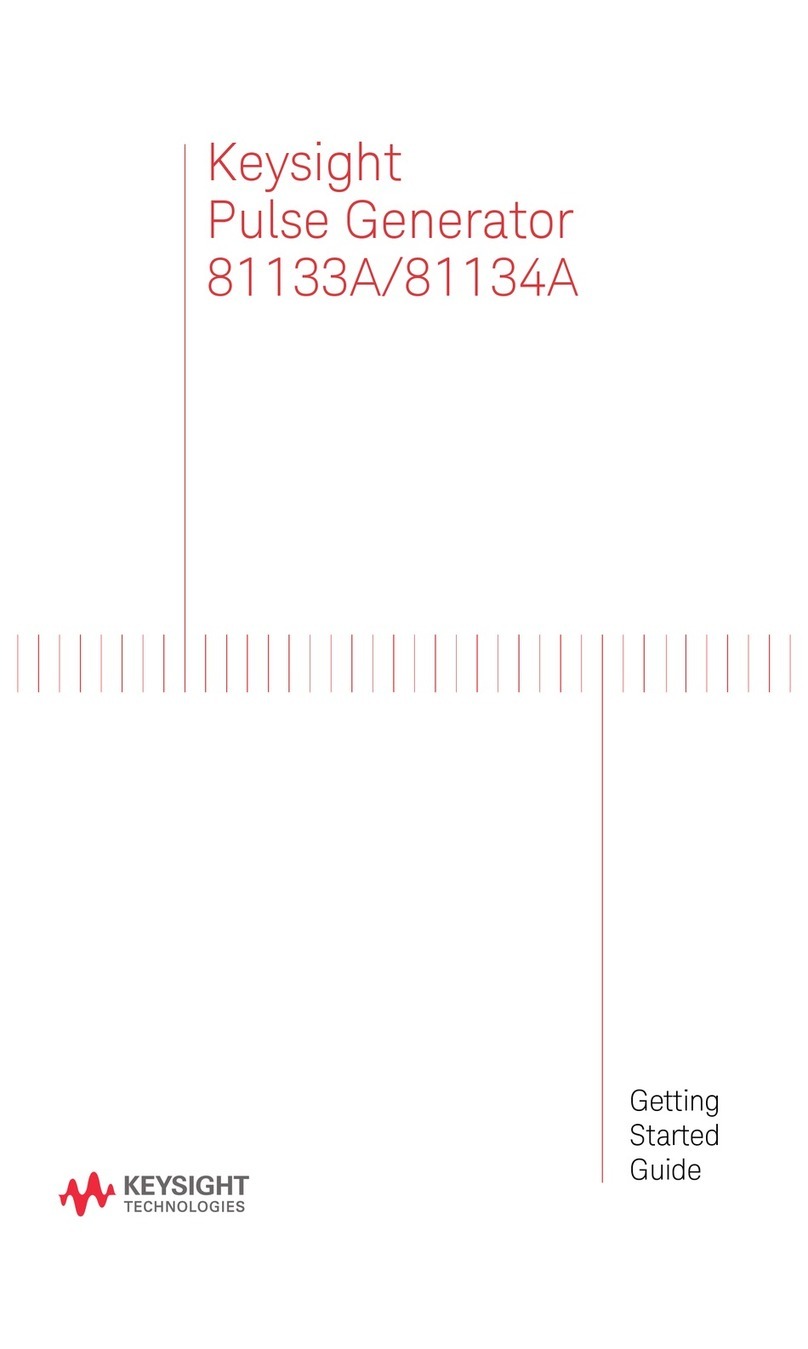EMC-PARTNER MIG-OS-OS1 User manual

23.04.2012 E-MIG-OS-OS1-MIG0603OSI-E-Manual 1/112
User Manual "Damped Oscillatory Wave Tester "
MIG-OS-OS1
Waveforms: damped oscillatory 100 kHz, 1MHz
MIG0603OSI
Waveforms: damped oscillatory 100 kHz, 1MHz, surge 1.2/50, 8/20 µs, 1.2/50 µs 0.5 J
MIG-OS-OS1 4UH and MIG0603OSI 8 UH
Title: MIG - Modular Impulse Generator
Date: 16.05.99
General Manager: M. Lutz
Service Manager: R. Henz
Revised: 18. December 2010
1 MHz, 100 kHz, SURGE 1.2/50, 8/20 µs, 1.2/50 µs 0.5J
MIG - Modular Impulse Generator

MIG-OS-OS1_MIG0603OS1_MIG0603OSI Modular Impulse Generator
2/112
ATTENTION
This user manual provides information necessary for operation of the test
equipment.
Throughout the users manual, standard references are used as an aid to
understanding only.
The relevant standard(s) must be obtained and used in conjunction with this
users manual
Declaration of Conformity
See sheets attached at the end of this user manual:
•Declaration of conformity to product standards
•Declaration of conformity to low voltage directive
•Declaration of conformity to EMC directive

MIG-OS-OS1_MIG0603OS1_MIG0603OSI Modular Impulse Generator
3/112
Contents:
1DESCRIPTION 8
1.1 The different application of the MIG0603-Oxx 8
1.1.1 Voltage "Damped Oscillatory Wave Tester 8
1.1.2 "CWG Combination Wave Generator" 9
1.1.3 Voltage tests with 1.2/50 µs 0.5 J and 500 Ω12
1.2 Combined MIG testers, Special MIG testers 13
1.2.1 Overview about the "Damped Oscillatory Testers 13
1.3 MIG generator range 14
1.3.1 Standard MIG Tester "Insulation, Energy, CWG 14
1.3.2 MIG Clamping Voltage Tester 14
1.3.3 MIG for varistors and gaze arresters tests 14
1.3.4 MIG for X,Y, capacitor tests, CWG 15
1.3.5 Combination wave tester CWG 15
1.4 Technical data 17
1.4.1 Voltage: 1 MHz, 100 kHz Damped Oscillatory Wave 17
1.4.2 Combination Wave Generator 1,2/50; 8/20 µs 19
1.4.3 Voltage tester 1,2/50, 0.5 J, 500 Ω20
1.4.4 General information to MIG control 21
1.4.5 Port "Auxiliary"; pin numbers 21
1.5 Mechanical dimensions 23
1.5.1 MIGxxxxOSx Tester 23
1.5.2 CDN2000-06-25 23
1.6 Power supply inputs 23
1.7 Accessories, diemensions 24
1.7.1 Included articles, dimensions 24
1.7.2 Standard accessories 25
2SAFETY 27
2.1 Safety standards 27
2.2 Climatic Conditions 27
2.3 Precautionary measure during use 28
2.4 Electromagnetic Compatibility 28
2.5 The manual is an integral part of the equipment. Refer to the manual. 28
3MECHANICAL STRUCTURE 29
3.1 General 29
3.2 EMC PARTNER High Voltage Module 30
3.3 Measuring Circuits CWG 30

MIG-OS-OS1_MIG0603OS1_MIG0603OSI Modular Impulse Generator
4/112
4CONTROL PANEL 31
4.1 Front panel of the MIG0603-Oxx 31
4.1.1 Control part 32
4.2 Rear Panel of the MIG0603-Oxx 35
5PREPARATION FOR OPERATION 39
5.1 Attention, Refer to Manual 39
5.2 Operators and Service Personnel 39
5.3 Checks before operation 39
5.3.1 Optical verification of the MIG0603-Oxx 39
5.3.2 Power source check 40
5.3.3 Connecting the MIG0603OMX to the power line 40
5.4 Hints for the test set-ups 41
5.4.1 Test set-up combination 1,2/50, 8/20 µs 41
5.4.2 Test set-up damped oscillatory wave 42
5.4.3 Test set-up for 0.5 J, 500 Ωtests 42
6TESTING WITH THE MIG0603-OXX 43
6.1 Quickstart of the MIG0603-Oxx 43
6.1.1 Selection of a language: Deutsch, Français, Italiano, Espagnol 45
6.1.2 Protocol and beeper possibilities 46
6.1.3 Damped oscillatory wave test 47
6.1.4 Combination Wave Test 47
6.1.5 Tester 0.5J, 500 Ohm 48
6.2 Description of different functions, Set-ups 49
6.2.1 Overview of programmable test with the MIG damped oscillatory testers. 49
6.2.2 „Main“ Setting of nominal values 50
6.2.3 „Ramp“ Automatic change of a parameter only active for SURGE and 1.2/50 0.5 J 55
6.3 High voltage "Start", "Stop"“ 58
6.3.1 Safety circuit 58
6.3.2 EUT Connections 59
7MAINTENANCE AND SERVICING 61
7.1 Maintenance 61
7.2 Verification of the MIG0603-Oxx by the user 61
7.2.1 Combination Wave Tester 61
7.2.2 Damped Oscillatory Wave tester 61
7.3 Verification of the MIG0603OMX at EMC PARTNER 62
8WHAT MUST BE DONE FOLLOWING FAILED OPERATION 63
8.1.1 Errors caused by incorrect inputs „Generator not ready for run“ 63
8.1.2 Failure messages based on error at the generator „Generator malfunction“ 64
8.1.3 Attention notice „Warning Generator stopped“ 65

MIG-OS-OS1_MIG0603OS1_MIG0603OSI Modular Impulse Generator
5/112
8.2 Service; Repairs 66
8.3 Spare parts list 66
8.4 Service department of EMC PARTNER AG 66
9PUTTING OUT OF OPERATION 67
10 PACKAGING AND TRANSPORT 69
10.1 Packaging 69
10.2 Transport 69
11 RECYCLING / DISPOSAL 71
11.1 Information for dismantling 71
11.2 Parts which can be recycled 71
11.3 Parts which can not be recycled 71
12 ACCESSORIES 73
12.1 Accessories to MIGxxxOxx System 73
12.1.1 Accessories to MIG-OS-OS, MIG0603OSI Testers 73
13 SERIAL REMOTE CONTROL 75
13.1 General 75
13.1.1 Technical Data of the RS 232C serial port 75
13.2 Organisation of MIG Remote-Control Commands 76
13.3 Syntax of the Commands 76
13.3.1 Separation signs: 76
13.3.2 Commands Format: 76
13.4 Setup Commands: 76
13.4.1 Inquire Commands 77
13.4.2 Failure messages: 77
13.5 Remote Control Command set 78
13.6 Overview MIG Commands 90
13.7 Software "GENECS" for MIG Remote Control 92
13.7.1 Setup GENECS 92
13.7.2 GENECS Windows 92
13.7.3 GENECS Library 92
13.7.4 GENECS Protocol possibilities 93
13.7.5 GENECS Log File 94
13.7.6 GENECS Preferences 95

MIG-OS-OS1_MIG0603OS1_MIG0603OSI Modular Impulse Generator
6/112
14 APPENDIX AND CORRECTION 97
14.1 Appendix 97
14.1.1 Definition of the wave form combination 97
14.1.2 Definition of the wave form energy ring wave 97
14.1.3 Definition of the wave form 10/700 µs 97
14.2 Correction 99
14.2.1 Declaration of conformity to the EMC directive 89/336/EEC 99
14.2.2 Declaration of conformity to the LV directive 93/68/EEC 99
14.2.3 Declaration of conformity to the Basic Standards 99
15 GLOSSARY 101
16 INDEX 103

MIG-OS-OS1_MIG0603OS1_MIG0603OSI Modular Impulse Generator
7/112

23.04.2012 E-MIG-OS-OS1-MIG0603OSI-E-Manual 8/112
1 Description
1.1 The different application of the MIG0603-Oxx
1.1.1 Voltage "Damped Oscillatory Wave Tester
Introduction: "
The damped oscillatory wave is a typical oscillatory transient, induced in low voltage supply of measuring
cables due to the switching of three phase electrical networks in HV/N`MV open air station.
In electrical stations, the opening and closing operations of HV isolators give rise to sharp front-wave
transients, with time of the order of some tens of nanoseconds. The voltage front-wave has an evolution
that includes reflection, due to mismatching of the characteristic impedance of HV circuits involved. In this
respect, the resulting transient voltage and current in HV busbars are characterised by a fundamental
oscillation frequency that depends on the length of the circuit and on the propagation time.
The oscillation frequency ranges from about 100 kHz to a few megahertz, depending on the influence of the
parameter mentioned above and the length of the busbars, which may vary from some tens of meters to
hundreds of meters. In this respect, the oscillation frequency of 1 MHz may considered respective of most
situations, but 100 kHz has been considered appropriate for large HV substations.
The repetition frequency is variable and a function of the distance between the switching contacts. The
minimum repetition frequency in respect of each phase, is twice the power frequency. The repetition rates
selected, 40/s and 400/s represents therefore a compromise, taking into account the different duration of
the phenomena, the suitability of the different frequencies considered and the problem related to the energy
to which the circuits under test are subjected.
Impedance of the test generator
For testing the input/output ports of measuring relays, the selection of the 200 Ohm impedance is a
compromise. This takes into account that the characteristic impedance of cables used for this purpose
(twisted pairs) has a value ranging from 120 to 150 Ohm in the frequency range above 100 kHz and for a
length of the order of 100 m. ANSI/IEEE C37.90.1 document a 150 Ωimpedance, frequency 1 to 1.5 MHz
are specified and 50% damping must be after 6 µs.
Relevant standards:
IEC 60255-4, IEC 6055-22-1, IEC 61000-4-18, IEC60834-1, VDE 435 Teil 303, ANSI/IEEE C37.90.1
C
S
LCb
Rs Rd
U
Damped oscillatory wave
Generator
V
olta
g
e at no load
U
t
T1 = rise time 75 ns
10 to 90 %
T = oscillation period
10 µs for 0,1MHz
1 µs for 1MHz
100%
50%

MIG-OS-OS1_MIG0603OS1_MIG0603OSI Modular Impulse Generator
9/112
1.1.2 "CWG Combination Wave Generator"
Introduction, "Combination wave test"
Long wires to sensors or supplies are very often connected to the inputs and outputs of industrial electronic
equipment. The most frequent damages are overvoltages, caused either by switching actions in the
equipment itself or by atmospheric discharges such as lightnings. To avoid the destruction of electronic
equipment by overvoltages, protection elements and circuits are placed at the inputs and outputs of the
equipment ports.
Consumer electronic devices such as antenna ports on television set, telephones, faxes, can also be
influenced by atmospheric discharges. Mostly the disturbances are tolerable because of their single event.
To protect such equipment from damages, protection elements and circuits are installed. Tests must be
carried out to determine whether these protective circuits are really effective.
The following aspects of surge testing electronic systems are relevant:
•Testing for failure modes that involve flashover are influenced by the surge current that would flow after
flashover.
•The surge let-through of a protective device depends on the applied voltage front.
•The response of a crowbar-type device, subjected to an intended current test, will be influenced by the
voltage front applied by the generator, that senses a high-impedance test piece, until operation of the
crowbar.
Therefore the generator must be capable to generate a waveform 1,2/50 µs or a current waveform of 8/20
µs at clamping status of the protection circuit. Traditionally, the 1,2/50 µs voltage waveform was used for
testing the basic impulse level of insulation, which is approximately an open circuit until the insulation fails.
The 8/20 µs current waveform was used to inject large currents into surge protective devices. Since both
the open circuit voltage and short circuit current are different aspects of the same phenomenon, such as an
overstress caused by lightning, it was necessary to combine them to a single waveform when the load is
not known in advance.
The combination wave generator has been defined first for Electro Magnetic Compatibility tests up to 4 kV
in the document IEC 61000-4-5 or IEEE 587. EMC test must be carried out on powered equipment. There
are several reasons for performing powered test:
•From a standpoint of a good practice, it is best to perform laboratory tests in a manner that most closely
simulates the actual service environment.
•It is the applied ac that furnishes the energy following the surge, that can establish sustained arcing
faults, tracking on insulation, destruction of printed wiring, and so on
•The application of normal ac power generally rises the EUT to an initial level of stress. Without power
current following a surge-induced flashover, the resulting defect might not be detected.
The loading by the EUT might cause appreciable discrepancy between the preset nominal voltage open-
circuit voltage or short circuit current and the actual voltage across or current in the load. This effect is the
reason why surge parameters are not specified with the EUT connected.
Equations for standards waveform:
1,2/50 µs Wave V t AVp tt
( ) ( exp )exp( )=−
−
−
112
ττ
8/20 µs Wave It AIpt t
( ) exp( )=
−
3
τ

MIG-OS-OS1_MIG0603OS1_MIG0603OSI Modular Impulse Generator
10/112
In all the equations above:
t = time
Vp = maximum or peak value of the open-circuit voltage
Ip = peak value of the short circuit current
Calculated waveform with the equation above:
1,2/50 µs Wave
8/20 µs Wave
The circuit diagram of a generator capable to generate the two waveform above is showed below.
Generators to carry out combination wave tests
Figure: 1.0.3-2
Legend:
RL Charging resistor Cs Impulse capacitor S High voltage switch
RE1 Discharge resistor Ls Inductance of the generator Rs Serial resistor
RM Shunt RE2 Discharge resistor TM1 Divider
Lv Inductance of the connection MS Measurement equipment TM2 Divider
A dc source charges the capacitors within the different modules via the charging resistors. Closing the
switch S discharge the capacitors into the parallel branches RE1, RE2 and EUT. When the EUT has a high
impedance the CWG generates a voltage rise defined by the serial inductance Ls and by the parallel
resistor RE2. The half value time is determined by Cs and the both RE1 // RE2. When the EUT has a low
impedance the generated current is determined by the elements Cs, Ls, Rs and the EUT.
The current and voltage waveforms are defined in IEC 61000-4-5 as follows:
Test generator CWG EUT, e.g. Motors

MIG-OS-OS1_MIG0603OS1_MIG0603OSI Modular Impulse Generator
11/112
Wave shapes and tolerances
Current into short circuit Voltage at no load Figure: 1.0.1-3
The waveforms are verified in open circuit (voc )and short circuit (isc). No load limitation exists, because for
different load impedance (EUT) the waveforms are within the open circuit voltage waveform and the short
circuit current waveform.
Superimposing surge onto power supply
To superimpose the surge pulses onto power line supply, coupling filters must be used. The aim of the
coupling filter is to couple the generated surge waveform without deformation of rise time, half value time
and amplitude onto the operated EUT and to protect the auxiliary equipment from surge pulses.
When surges are superimposed onto power supply lines, the synchronisation angle must be chosen to
correspond to the half wave of the power supply. The picture below shows that pseudo tests can be carried
out, when the synchronisation angle is not correctly selected. When a positive surge is superimposed at
270°, the clamping voltage of the varistor is not reached and no real test is carried out.
Figure: 1.0.1-4
Rise time:
Ts=8 µs ± 20%
Half value time:
Tr = 20 µs ± 20%
Under swing:
ü < 30 %
90%
50%
10%
100%
I
[A] U
[V] 100%
50%
20 µs
8 µs
Ü<30%
50 µs
1,2 µs
Rise time:
Ts=1,2 µs ± 30%
Half value time:
Tr = 50 µs ± 20%
Over swing:
ü < 5 %
90%
Protection circuit
Teste
r
Filte
r
Cou
p
lin
g
Superposing sure at
different angle

MIG-OS-OS1_MIG0603OS1_MIG0603OSI Modular Impulse Generator
12/112
1.1.3 Voltage tests with 1.2/50 µs 0.5 J and 500 Ω
Impulse withstand test 1.2/50 µs
The classic insulation withstand test is carried out with a 1.2/50 µs waveform. This waveform must remain
within tolerances, when applied to device under test. As long as the devices under test are resistive,
capacitive or inductive the 1.2/50µs wave shape can be kept within the tolerances. With protection circuits
involved, it is no longer possible to keep the waveform within tolerances. As a consequence in IEC 255-5 a
generator and a test procedure are specified for insulation withstand tests based on a defined source
energy and impedance. The waveform is verified without the device under test. During tests the waveform
must not be monitored.
Impedance of the test generator
The 500 ohm serial resistor of the generator defines the source impedance and limits the current through
the device under test. The maximum energy of the generator must be 0.5 Joule ± 10% for each test level.
Circuit of the generator as defined in IEC 834-1, (IEC 255-4)
Relevant standards: IEC 255-5, 834-1 EN 61036, VDE 435 Teil 303
Test voltage Energy Generator-
impedance Impulse
Capacitor Voltage
waveform oc Current waveform
sc
0.5 kV 0.5 J 500 Ohm 4.0 µF 0.5kV 1.2/50us 1A 1.2/50us
1 kV 0.5 J 500 Ohm 1.0 µF 1kV 1.2/50us 2A 1.2/40us
3 kV 0.5 J 500 Ohm 110 nF 3kV 1.2/50us 6A 1.2/25us
5 kV 0.5 J 500 Ohm 40 nF 5kV 1.2/50us 10A 1.2/10us

MIG-OS-OS1_MIG0603OS1_MIG0603OSI Modular Impulse Generator
13/112
1.2 Combined MIG testers, Special MIG testers
1.2.1 Overview about the "Damped Oscillatory Testers
1.2.1.1 MIG Voltage Oscillatory Wave Testers
Pos. Product No. Type Short Description Delivery
97 MIG1A103C MIG-OS-OS1 IEC 255-4, ANSI C37.90.1 and 22 or IEC 61000-4-
18 section "damped oscillatory wave" 1MHz and
100kHz up to 3kV
1 month
99 MIG1A102C MIG0603OSI 1MHz and 100kHz up to 3kV; CWG 6kV, 3kA,
1.2/50µs 0.5J up to 6kV, IEC 61000-4-18, 61000-4-5
without CDN, 60255-4 and -5
1 month
1.2.1.2 Accessory to MIG Voltage Oscillatory Wave Testers
Pos. Product No. Type Short Description Delivery
100 MIG1A92C CDN2000-06-
25 Three phase CDN with line voltages L to N 280V
and L to L 415V, line current 25A per phase,
manually coupling path selection for EFT, damped
oscillatory and SURGE. Incl. accessories according
to user manual
from stock
101 MIG1A352C CDN2000-06-
25 OPTION
480V
Three phase CDN with line voltages L to N 280V
and L to L 480V, line current 25A per phase,
manually coupling path selection for EFT, damped
oscillatory, SURGE and Ring Wave. Incl accessories
according to user manual
1 month
Special generators on demand

MIG-OS-OS1_MIG0603OS1_MIG0603OSI Modular Impulse Generator
14/112
1.3 MIG generator range
With the MIG current generators also other applications are possible like: measurement of earth
impedance, impulse impedance of connectors, release of fault current switches, demagnetisation of
magnetic metal, etc.
1.3.1 Standard MIG Tester "Insulation, Energy, CWG
Insulation
Application:
voltage withstand tests
Waveform: 1,2/50 µs voltage
Range: 0 to 100 kV:12, 24, 36, 48, 96 kV
Standards: IEC 60060-1, -2, IEC 61010
Energy
Application:
protection elements
Waveform: 8/20 µs current
Range: 0 to 100 kA: 6, 12, 24, 48kA
Standards: IEC 60060-1, -2, IEC 61643-1
Combination
Application:
powered surge tests
Waveforms: 8/20 µs current
1,2/50 µs voltage
Range: 0 to 24 kV, 0 to 12 kA
Standard: IEC 61000-4-5
Other waveforms on demand.
1.3.2 MIG Clamping Voltage Tester
Clamping Voltage Tester
Application:
Varistors Vclp =<3000V
Waveforms: 8/20 µs current
Impedance: 10, 100, 1000 Ohm
Range: 0,5 A up to 500 A
Standard: IEC 61643-1
1.3.3 MIG for varistors and gaze arresters tests
Surge Withstand Tester
Application:
SURGE peak current test on Varistors up
to Vclp = 3000 V
Waveforms: 8/20 µs current
Impedance: 1, 0.5, 0.25 Ohm
Range: 100 A up to 100’000A
Standard: IEC 61643-1
Energy Tester
Application:
Energy test on Varistors
Waveforms: 10/1000 µs current
Range: 0,4 up to 750 A
Standard: IEC

MIG-OS-OS1_MIG0603OS1_MIG0603OSI Modular Impulse Generator
15/112
Dual Surge Tester K12
Application:
SURGE peak current test on Two electrode
gaze arrestor
Waveforms: i = 8/20, 10/700, 10/350 µs
Range: 2 x i = 6’000, 120, 240 A
1 x i = 10’000, 240, 480 A
Standard: UIT K12
The „MIG0603K12 is a dual output surge current generator for testing protective elements like arresters, or
Transzorbe diodes with different waveforms.
The dual output allows testing of three electrode elements .The current ranges are: for 8/20 µs up to
2x6'000 A, for 10/700 µs up to 2x120 A and for 10/350 µs up to 2x240 A.
For two electrode elements the outputs of the generator can be connected in parallel, to increase the
current capability up to 240 A for 10/700 µs, 480 A for 10/350 µs and 12 kA for 8/20 µs.
The charging voltage up to 6300 V is sufficient for most of the protection elements, also for elements with
relatively high clamping voltages.
The peak output voltage and current of the MIG are indicated on the front display. The two BNC monitor
outputs (v,i) allow monitoring the voltage and current wave shapes by an oscilloscope connected onto.
1.3.4 MIG for X,Y, capacitor tests, CWG
1,2/50 µs Capacitor Tester
Application:
Insulation test on X, Y capacitors
Waveforms: 1,2/50 µs voltage
Resistor: 3, 5, 7, 9, 13, 25, 27, 45, 62
Range: 0 up to 2 µF
Standard: IEC 60348-14
Flammability Tester
Application:
flammability test on X, Y capacitors
Range:
capacitors up to 4 µF Vmax 6000V
capacitor up to 10 µF Vmax 4000V
Standard: IEC 60348-14 Amd. 1
1.3.5 Combination wave tester CWG
Different Surges
Application:
Household equipment, Telecommunication
equipment
Waveforms: 1,2/50 µs, 8/20 µs CWG
Options: Ring wave 0.5 µs, 100 kHz
10/700 µs
Range: 0.25 to 6.6 kV
Coupling: for single phase included
Standards: IEC 61000-4-5,
IEC 61000-4-12, UIT K17
MIG0603IN
The MIG0603-IN can include up to three different waveforms like: CWG (1,2/50; 8/20 ); CCITT (10/700,
0,5/700) or ANSI, IEC 61000-4-12 ring wave 0,5/100kHz.
The MIG0603IN is a surge generator for simulation of indirect lightning on telecom and process and
measurement lines. The relevant recommendations are CCITT K17 and IEC 61000-4-5.
The MIG0603IN is a hybrid generator with a voltage waveshape 1,2/50 µs at "no load" and a current wave-
form 8/20 µs at short circuit.
At 2 Ohm source impedance of the MIG0603IN, the voltage and current waveform can be guaranteed at
the terminal of a 1 m connection cable. Instead of the cable connection a test cabinet can be placed on the
top of the generator. The test cabinet is so designed that the cover can not be opened during the test. The
green and red warning lamps are integrated in the test cabinet.
The peak output voltage and current of the MIG are indicated on the display. The two BNC monitor outputs
allow monitoring the voltage and current wave shapes by an oscilloscope

MIG-OS-OS1_MIG0603OS1_MIG0603OSI Modular Impulse Generator
16/112
Surge Between Two Lines
Application:
equipment, varistors
Waveform: 1,2/50 µs, 8/20 µs CWG
Impedance:2 and 12 Ohm
Ranges: current 3’000A or 500 A
voltage 0 up to 6’000 V
Coupling: between two line included
Standards: UL 1449 August 15. 1996
MIG0606UL
The MIG0603UL is a Hybrid or combination generator with a voltage wave shape 1,2/50 µs and a current
wave shape 8/20 µs. The combination waves are delivered by the MIG0603UL when applying the specified
voltage waveform across an open circuit (oc) and the specified current waveform into a short circuit (sc).
The exact waveform delivered is a function of the surge generator and the impedance to which the surge is
applied.
The peak output voltage and current of the MIG are indicated on the front display. The two BNC monitor
outputs (v,i) allow monitoring the voltage and current wave shapes by an oscilloscope connected onto.
A coupling and de-coupling network is included to superimpose the SURGE on a two wire power supply.
Should you have test needs not listed above, contact an EMC PARTNER representative, direct EMC
PARTNER AG in Laufen (CH) or visit our Web Site
www//emc-partner.com
www//emc-partner.ch

MIG-OS-OS1_MIG0603OS1_MIG0603OSI Modular Impulse Generator
17/112
1.4 Technical data
1.4.1 Voltage: 1 MHz, 100 kHz Damped Oscillatory Wave
1.4.1.1 Voltage 1 MHz, 100 kHz IEC 61000-4-18
Waveform at no load: No load = R > 1kΩ
Rise time 75ns ± 20%
Oscillation frequency 1 MHz ± 10%
Decay: 50% of the peak value between the 3rd and
6th periods
Adjustable voltage range 200 up to 3000 V
Settings 1 V steps
Maximum voltage 3000 V +10% -0%
Burst repetition rate 2/s to 400/s to 500/s +10% -0%
Test duration 1s to 2s to 29999 +10% -0%
Polarity pos. / neg. / alternate
Random Pulses on / off
Burst Synchronisation on / off
Synchronisation Angle 0°to 360°
Synchronisation Frequency 40Hz / 50Hz / 60Hz / 400Hz / 16.6Hz
MIG0603OSI Circuit Parameter
Source impedance Umax. / Imax 200 Ω± 10%
MIG0603OSI Control, Measurement
Trigger auto or manual synchronisation
Protocol Peak values, Polarity, Trigger, Pulse Spacing,
Burst Length, Repetition, Random Spikes,
Burst Synchro
Voltage 100 kHz, IEC 61000-4-18
Waveform at no load: No load = R > 1kΩ
Rise time 75ns ± 20%
Oscillation frequency 100 kHz ± 10%
Decay: 50% of the peak value between the 3rd and
6th periods
Adjustable voltage range 200 up to 3000 V
Settings 1 V steps
Maximum voltage 3000 V +10% -0%
Burst repetition rate 2/s to 40/s to 50/s +10% -0%
Test duration 1s to 2s to 29999 +10% -0%
Polarity pos. / neg. / alternate
Random Pulses on / off
Burst Synchronisation on / off
Synchronisation Angle 0°to 360°
Synchronisation Frequency 40Hz / 50Hz / 60Hz / 400Hz / 16.6Hz

MIG-OS-OS1_MIG0603OS1_MIG0603OSI Modular Impulse Generator
18/112
MIG0603OSI Circuit Parameter
Source impedance Umax. / Imax 200 Ω± 10%
MIG0603OSI Control, Measurement
Trigger auto or manual synchronisation
Protocol Peak values, Polarity, Trigger, Pulse Spacing,
Burst Length, Repetition, Random Spikes,
Burst Synchro
1.4.1.2 Voltage 1 MHz, ANSI/IEEE C37.901 (1989)
Waveform at no load: No load = R > 1kΩ
Rise time 75ns 50 up to 100 ns
Oscillation frequency 1 up to 1.5 MHz
Decay: 50% of the peak value after 6 µs
Adjustable voltage range 200 up to 3000 V
Settings 1 V steps
Maximum voltage 3000 V ±10%
Burst repetition rate 2/s to 400/s to 500/s +10% -0%
Test duration 1s to 2s to 29999 +10% -0%
Polarity neg.
Random Pulses on / off
Burst Synchronisation on / off
Synchronisation Angle 0°to 360°
Synchronisation Frequency 40Hz / 50Hz / 60Hz / 400Hz / 16.6Hz
MIG0603OSI Circuit Parameter
Source impedance Umax. / Imax 150 Ω± 10%
MIG0603OSI Control, Measurement
Trigger auto or manual synchronisation
Protocol Peak values, Polarity, Trigger, Pulse Spacing,
Burst Length, Repetition, Random Spikes,
Burst Synchro

MIG-OS-OS1_MIG0603OS1_MIG0603OSI Modular Impulse Generator
19/112
1.4.2 Combination Wave Generator 1,2/50; 8/20 µs
SURGE part
Waveform at no load: No load = R > 100 Ω
Rise time 1.2 µs ± 30%
Time to half value 50 µs ± 20%
Adjustable voltage range 250 V up to 6'300 V
Settings 1 V steps
Maximum voltage 6000 V +10% -0%
Minimum Voltage 500 V -10% +0%
Polarity pos. / neg. / alternate
Waveform at short circuit: Short circuit R < 0,1 Ω
Rise time 8 µs ± 20%
Time to half value 20 µs ± 20%
Underswing < 30%
Maximum current 3000 A +10% -0%
MIG0603OSI Circuit Parameter
Impulse capacitance 10 µF ± 10%
Energy at max. charging voltage 220 Joule
Source impedance Umax. / Imax. 2 Ω± 10%
MIG0603OSI Control, Measurement
Minimum time between successive
shots at maximum charging voltage 8 Seconds 1s steps
Impulse counter 1 up to 29'999
Trigger auto or manual synchronisation onto the
power line voltage
Ramps - Voltage; - Polarity, - Synchronisation
Voltage measurement:
Peak value on Display
Voltage waveform BNC output (u)
Accuracy
250 up to 6'600 V
10 V equals 6'000 V
± 3%
Current measurement:
Peak value on Display
Current waveform BNC output (i)
Accuracy
125 up to 3'300 A
10 V equals 3'000 A
± 3%
Protocol Peak values, Polarity, Number of shots, Angle
of Synchronisation
Limits on peak current and peak
voltage for "passed - failed". The
measuring range equal of current
and voltage peak values
•stop test
•protocol
•next test

MIG-OS-OS1_MIG0603OS1_MIG0603OSI Modular Impulse Generator
20/112
1.4.3 Voltage tester 1,2/50, 0.5 J, 500 Ω
SURGE part
Waveform at no load: No load = R > 100 Ω
Rise time 1.2 µs ± 30%
Time to half value 50 µs ± 20%
Adjustable voltage range 250 V up to 6'300 V
Automatic range changing 250 v up to 575 V
575 up to 1150 V
1150 V up to 3450 V
3450 V up to 6300 V
4 µF
1 µF
110 nF
40 nF
Settings 1 V steps
Maximum voltage 6000 V +10% -0%
Minimum Voltage 500 V -10% +0%
Polarity pos. / neg. / alternate
Test voltage Energy Generator-
impedance Impulse
Capacitor Voltage
waveform oc Current
waveform sc
0.5 kV 0.5 J 500 Ohm 4.0 uF 0.5kV 1.2/50us 1A 1.2/50us
1 kV 0.5 J 500 Ohm 1.0 uF 1kV 1.2/50us 2A 1.2/40us
2.5 kV 0.5 J 500 Ohm 120 nF 2.5kV 1.2/50us 6A 1.2/30us
5 kV 0.5 J 500 Ohm 40 nF 5kV 1.2/50us 10A 1.2/10us
MIG0603OSI Control, Measurement
Minimum time between successive
shots at maximum charging voltage 8 Seconds steps
Impulse counter 1 up to 29'999
Trigger auto or manual synchronisation onto the
power line voltage
Ramps - Voltage; - Polarity, - Synchronisation
Voltage measurement:
Peak value on Display
Voltage waveform BNC output (u)
Accuracy
250 up to 6'600 V
10 V equals 6'000 V
± 3%
Current measurement:
Peak value on Display
Current waveform BNC output (i)
Accuracy
125 up to 3'300 A
10 V equals 3'000 A
± 3%
Protocol Peak values, Polarity, Number of shots, Angle
of Synchronisation
Limits on peak current and peak
voltage for "passed - failed". The
measuring range equal of current
and voltage peak values
•stop test
•protocol
•next test
This manual suits for next models
3
Table of contents
Popular Pulse Generator manuals by other brands
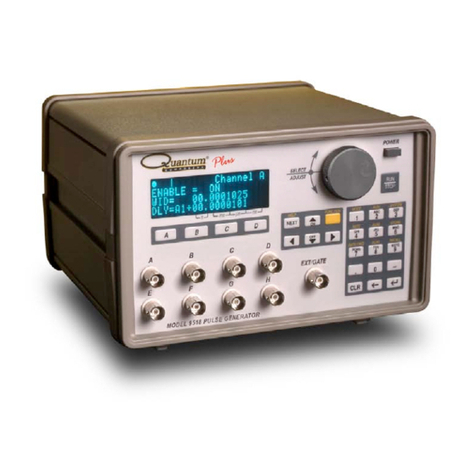
Quantum Composers
Quantum Composers 9510+ Series datasheet
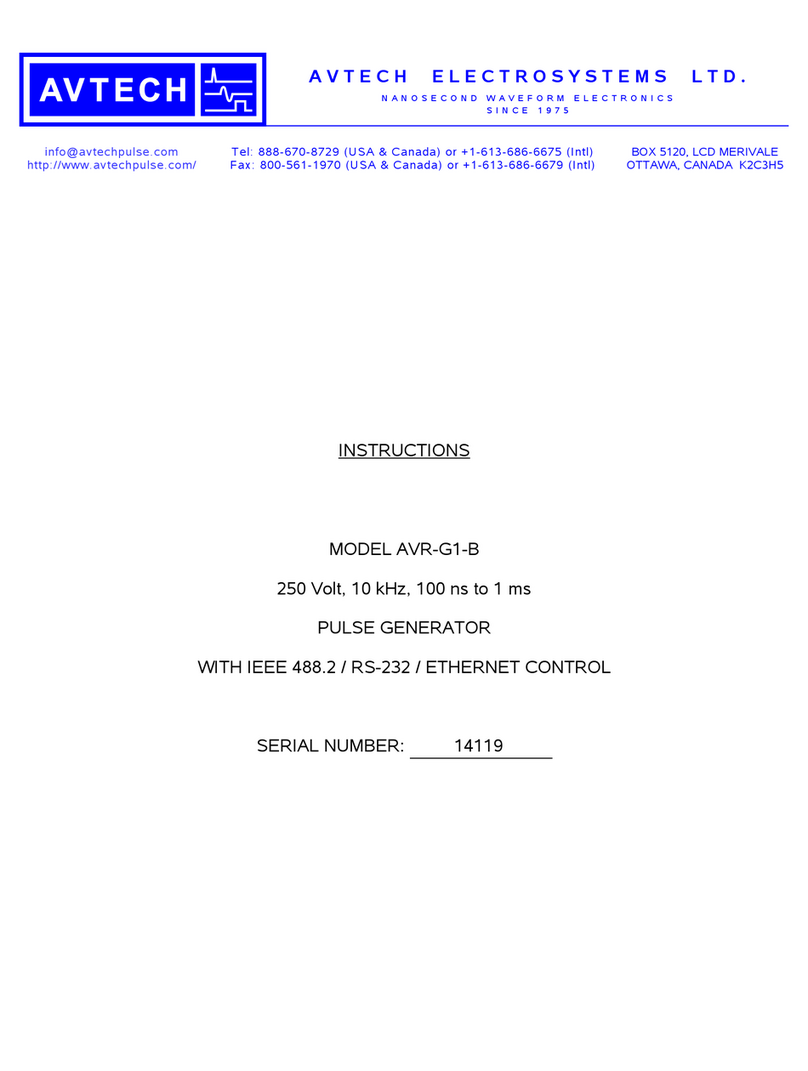
Avtech
Avtech AVR-G1-B instructions
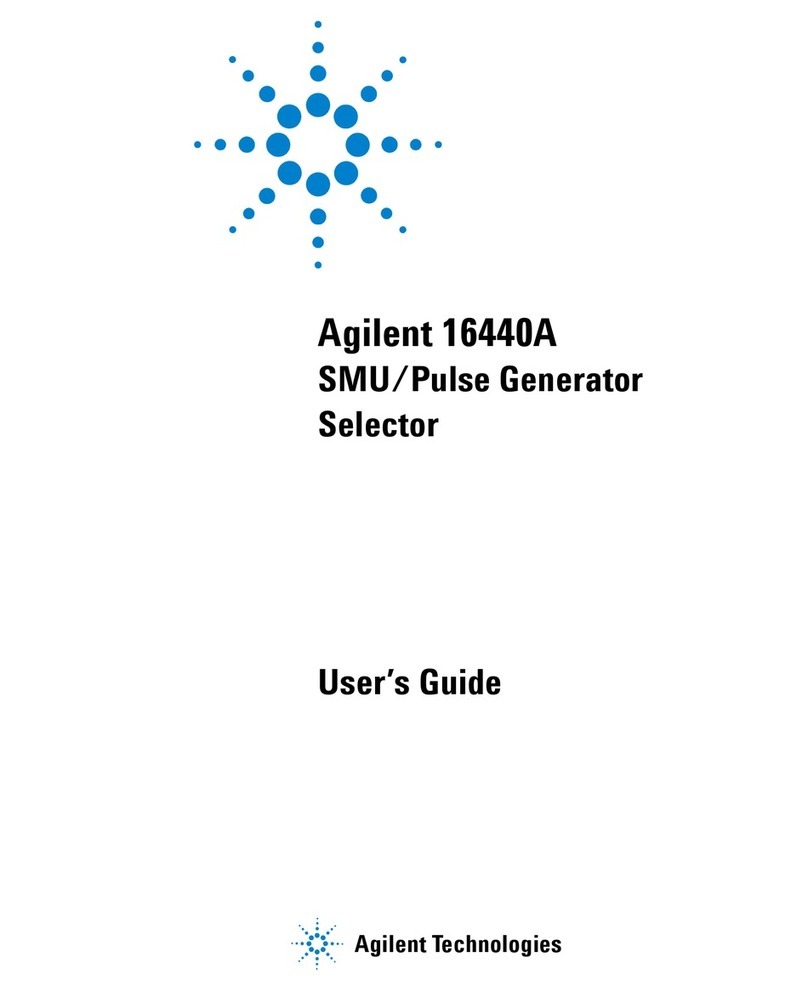
Agilent Technologies
Agilent Technologies 16440A user guide
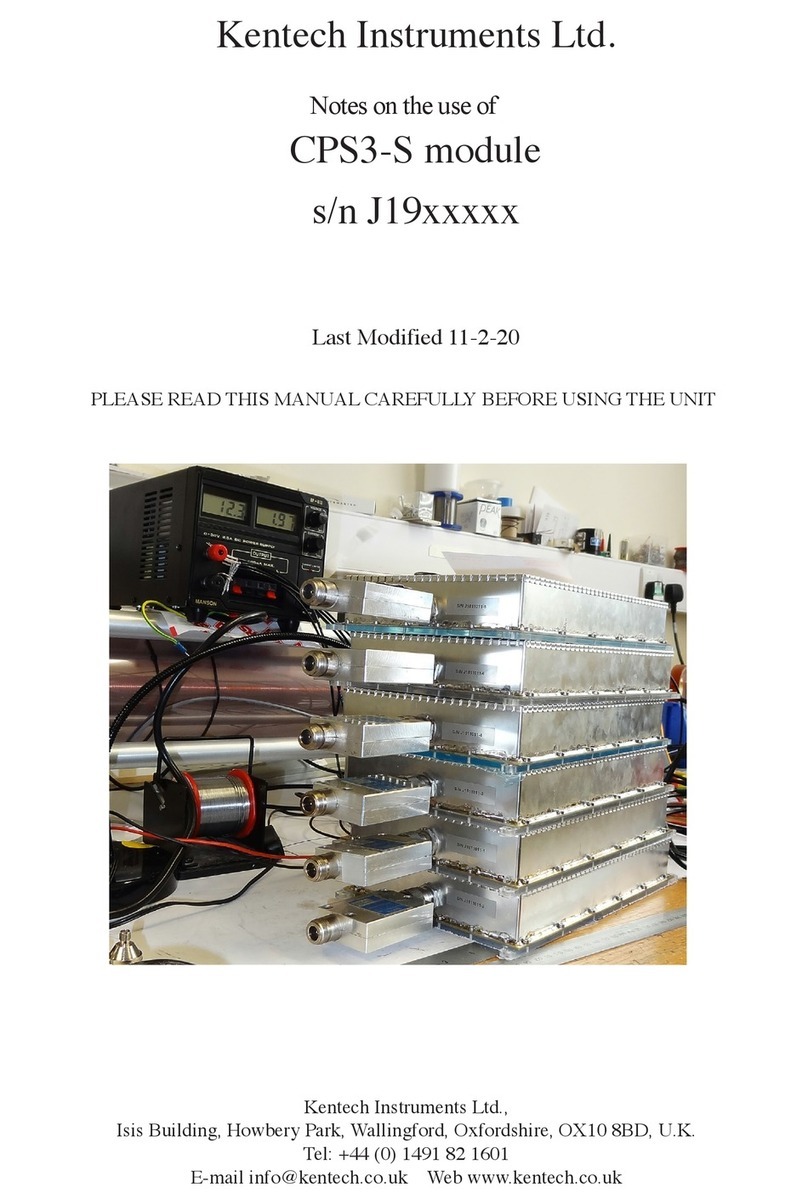
Kentech Instruments
Kentech Instruments CPS3-S Notes on the Use
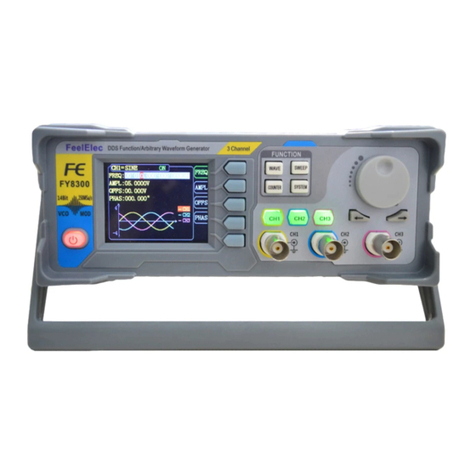
FeelElec
FeelElec FY8300 Series user manual

Stanford Research Systems
Stanford Research Systems DG535 Operation and service manual
